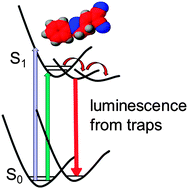On the origin of fluorescence emission in optically non-linear DCNP crystals†
Abstract
We study absorption and emission spectra of optically nonlinear single crystals of 3-(1,1-dicyanoethenyl)-1-phenyl-4,5-dihydro-1H-pyrazole (DCNP) at 5 K. We argue that fluorescence has a complex origin, it is emitted from the excitonic band, with the bottom at ∼18 115 cm−1, and from trap states, and the two main traps have depths of ∼875 and ∼2465 cm−1. The excitonic origin of the emission is confirmed by the vibrational structure of fluorescence, closely resembling vibrations observed in the Raman scattering spectrum (recorded for DCNP crystals at 295 K) and by very short decay time of the excitonic emission, as a consequence of exciton migration and trapping at deep traps.


 Please wait while we load your content...
Please wait while we load your content...